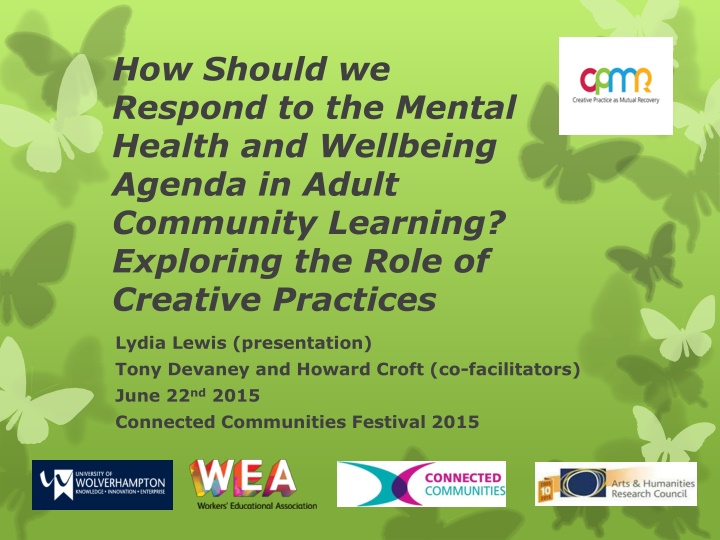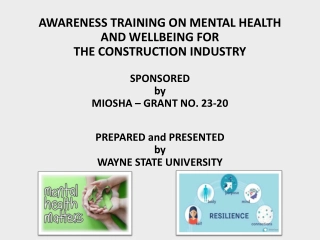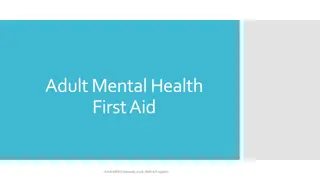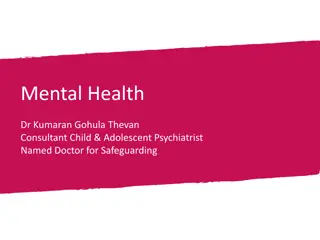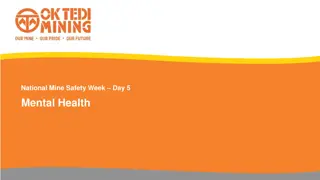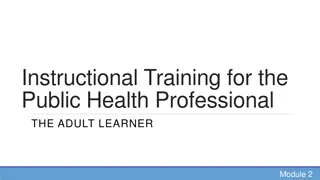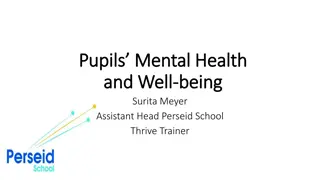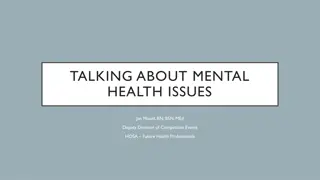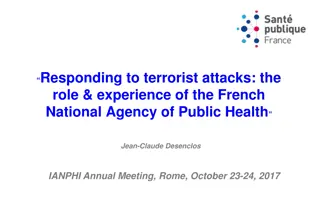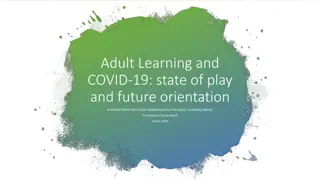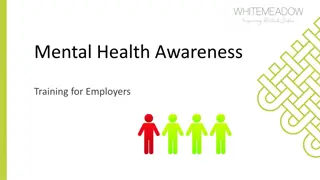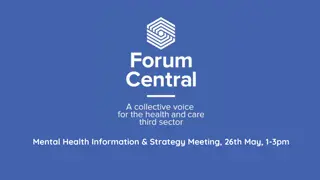Responding to Mental Health in Adult Learning
Engage critically with mental health and wellbeing in adult community learning, focusing on the role of creative practices. Explore key policy issues, participation through creative practices, and progression in educational and recovery journeys.
Download Presentation

Please find below an Image/Link to download the presentation.
The content on the website is provided AS IS for your information and personal use only. It may not be sold, licensed, or shared on other websites without obtaining consent from the author.If you encounter any issues during the download, it is possible that the publisher has removed the file from their server.
You are allowed to download the files provided on this website for personal or commercial use, subject to the condition that they are used lawfully. All files are the property of their respective owners.
The content on the website is provided AS IS for your information and personal use only. It may not be sold, licensed, or shared on other websites without obtaining consent from the author.
E N D
Presentation Transcript
How Should we Respond to the Mental Health and Wellbeing Agenda in Adult Community Learning? Exploring the Role of Creative Practices Lydia Lewis (presentation) Tony Devaney and Howard Croft (co-facilitators) June 22nd2015 Connected Communities Festival 2015
Research Project: Mutuality, wellbeing and mental health recovery: Exploring creative adult community learning and participatory arts initiatives Project team: Lydia Lewis (lead), Tony Devaney, Kathryn Ecclestone, Helen Spandler, Jerry Tew, Janet Wallcraft and Clare White
Session purpose To engage critically with debates surrounding the mental health and wellbeing agenda for adult community learning (ACL), with particular consideration of creative provision.
I think the bit thats missing is getting it out there into the community and saying, Look, this is what s helped . ( Reablement art group participant)
Mental health and wellbeing agenda: Key policy issues for ACL
Participation and inclusion the role of creative practices Soft subjects Allows for a have a go approach Can absorb social interactions without necessarily having to speak Visual arts not dependent on language literacy Jewellery-making can follow a pattern
Progression Walking into the [learning] circle was quite difficult for me but walking into a a college course where everybody was really good at art would've been something I just wouldn t've even considered ( ) But I would consider that now; I would consider doing a degree now, if I could afford it. So having this as a base to , as sort've a stepping stone almost, to help people, you know. (Mainstream art course participant)
Utilitarian policy objectives - problems of pressure to recover Time-limited interventions with the immediate aim of getting back into employment seen as potentially counter-productive. It gives you the time to breathe as far as looking at doing other things. (Art studio member)
Tension between maintenance and recovery I: Are people, sort of, encouraged to progress? IV:Not necessarily, because a lot of people don t want to, that s the thing. It s, like, that s not where they want to go. And, also, you can feel pushed [and] it can be quite scary. ( ) There are people who have been here for, like, 15 years. And a lot of people here are older. If you re 70 you re not really gonna be thinking, Oh, I must go and do a course and progress; you might just wanna do your art. So I think it s good here. If you wanna do a course, they ll help you, but if you just wanna carry on doing what you re doing, that s okay, you know. (Art studio member)
Targeted provision and inclusion enabling participation and support Well, I m getting, I'm meeting people, and having friends, which I don t usually have, and I'm getting to talk to people that are in the same situation as me, so you don t get stigmatised. It's conversation and for that two hours you can talk to somebody instead of talking to the brick wall or the television, you know. ( ) So it's, it's a time of not spending a lotta time on your own, you, you got people around you, and perhaps you can get things off your chest that you wouldn t do if you was indoors. (Poetry group participant)
Mutual understanding and comfort zone ? I think I would be, feel embarrassed going in a group of people who didn t , because people who haven t suffered mental health [issues] are very judgemental and they don t understand and so you feel uncomfortable. ( ) And so you kind of like hide it if anything, whereas in this group you don t have to hide it and we all understand, we all have empathy for each other whereas other people don t have empathy so I wouldn t feel so comfortable with them. ( Enablement group participant)
Discourse of confidence and self esteem Social problems become repackaged as individual, psychological problems that require therapy. (Mirza, 2006 p. 104) Dangers of interpretation in which social context and lack of opportunities sublimated Replacing the creative, intellectual, more radical and emancipatory purposes of adult education (Thompson, 2007)?
Discourse of confidence and self esteem Strong theme among participants and practitioners esp. applied to women Slippage between confidence in relation to subject and personal/social confidence Situated phenomenon (Eldred et al, 2004)
Valuing or devaluing art? Increasing focus and funding Relativist view your interpretation No criticism No pressure Anything worth doing is worth doing badly combatting hyper perfectionism
Art activity empowering or anaesthetic? Helps you to process experiences. (Art tutor) Relaxing helps deal with anxiety and with decision-making A process that allows you to move through things and come out in a different place. (Art tutor)
Art activity empowering or anaesthetic? Participants needing to stay calm. (Support worker) Takes my mind off my worries; a way of me shutting all my problems behind me. (Jewellery- making group participants) The tutor understands about these [mental health] issues and she puts you totally at ease but she doesn t make the lesson all about your problems. You know she might talk a bit about it at the start but then try and distract you, it s a distraction ( ), art is a distraction, it s therapeutic. (Targeted art group participant)
Creative groups: Generating mutual Support I think mutuality, she s been helped by the group, I think. ( ) As well as the art activity there is the group process going on in the way that we run our groups. So there is a lot of mutuality and the sharing. I think as well you can create a culture of safety so that people can then share quite personal aspects of what s going on in their lives and the joy of most, well all the groups I work with at the moment, is that individuals know they will get support from group members if they do have the courage to share. We had a big experience of that in [named] group when [student] shared what was happening in her domestic setting and she got a tremendous amount of support from the group, so (Targeted art groups tutor)
Creative classroom modelling a social system Empower[ing] people to be able to take responsibility and make their own decisions and even on a small scale actually providing individuals with like masses of choice with their art materials; if you look at it in a micro level it s all about people starting to make decisions and choices and allow themselves to try new things. (Targeted arts group tutor)
Revival of crafting how should we understand this from a feminist perspective? Jewellery-making group: We enjoy it; we have a banter and we have a laugh. Everybody joins in and starts talking, and then that s it, everybody joins in then, you know, talking. ...The beads have gone then, you know. I really enjoy it and I like the atmosphere of the people and it takes me out of myself and we have a laugh and everything. It s just brought me out of my shell, I ll tell you.
Questions for discussion What do you think are the implications of the findings for creative adult community learning provision? Do they shed light on any of the policy & critical debates outlined? Are there key recommendations that you would make based on the findings?
References Belzer, A. (2004), Blundering toward critical pedagogy: True tales from the adult literacy classroom, New Directions for Adult and Continuing Education, 102, pp. 5-13. Castillo, Heather, Ramon, S. and Morant, N. (2013), A recovery journey for people with personality disorder, International Journal of Social Psychiatry, 59 (3), pp. 264-273. Coyne, G. 2011. Developing a Radical, Action-learning Oriented Educational Approach in the WEA to Deal with Old Challenges in New Times. Working Paper. Http://blogs.erratum.org.uk/author/admin/ Edwards, A., & Mackenzie, L. (2005), Steps towards participation: The social support of learning trajectories, International Journal of Lifelong Education, 24(4), pp. 282 302. Eldred, J., Ward, J., Dutton, Y and Snowdon, K. (2004), Catching Confidence. Leicester: NIACE. Lewis, L. (2014), Responding to the mental health and wellbeing agenda in adult community learning, Research in Post-Compulsory Education, 19 (4), pp. 357-377. McKinney, (2012), Adult Education for Health and Wellness: New Directions for Adult and Continuing Education, Number 130 [Book Review], Journal of Research and Practice for Adult Literacy, Secondary and Basic Education, 1 (2) pp. 120-122. Mirza, M. (2006), The Arts as Painkiller, Culture Vultures: Is UK Arts Policy Damaging the Arts? London: Policy Exchange. Thompson, J. (2007), More words in edgeways. Rediscovering Adult Education. Leicester: NIACE.
